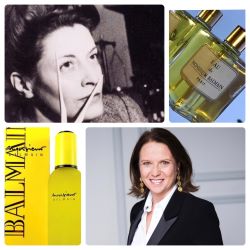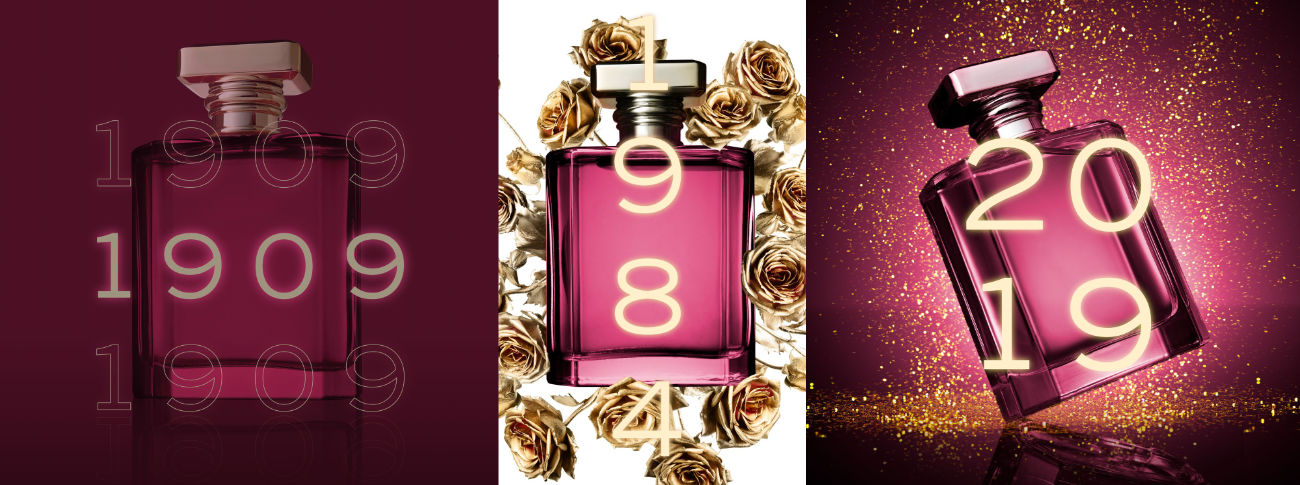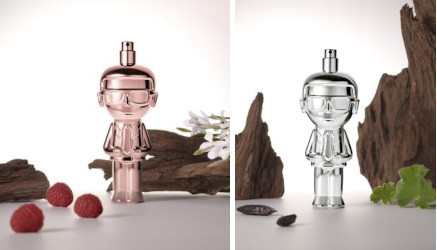Monsieur Balmain ads circa 1960s left and1990 right courtesy of Balmain collage by Michelyn
By now, it must be reasonably apparent how fond I am of the house of Balmain; I’ve certainly written enough about it (this will be my sixth review!). Frankly, other than Jolie Madame and some gushing over Vent Vert – you don’t hear much about Balmain these days. As needs must (due to IFRA restrictions) they have altered their original fragrances, which have since been reworked by highly-regarded current day perfumers – some of whom have been more successful than others. As in all things, it’s a matter of taste and experience: many perfumistas haven’t smelt the initial versions and/or are very fond of the currently available variants – or they are unfamiliar with Balmain perfumes in general. For me, Monsieur Balmain of 1964 and 1990 possess many charms, and both are exquisite; I can’t speak to the most recent iteration in the cube-shaped flacon, as I haven’t come across it and don’t know whether or not it has been tweaked (a practice which occurs periodically).
We, the perfume-loving population – can be quite demanding consumers: we want our fragrances to possess nuclear sillage and post-apocalyptic longevity. I read a great many comments daily in which folk lament that their eaux de toilettes and colognes don’t last all day – which is, by very definition, their evanescent nature. This is likely why gems such as Monsieur Balmain fly under the radar, and that is a shame – especially because (in the Northern Hemisphere, at least) now is the perfect time to enjoy them, chilled or at room temperature. Regardless of the season or occasion, one will always smell effortlessly chic and soigné, but they absolutely [sic] sing in the summertime.
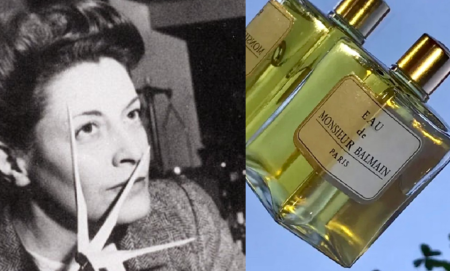
Germain Cellier via wiki and Vintage Monsieur Balmain Ida purchased on eBay collage by Michelyn©
Madame Germaine Cellier’s 1964 composition is a lovely thing to behold: it is bracing and finely nuanced, with an enigmatic, smoldering base consisting of pre-IFRA oakmoss, heady musk, and soft hues of cedar, patchouli, and leather. Lemon, lemongrass, and bergamot conspire to evoke a brilliant sun accented with tangy ginger. One cannot miss the presence of basil and jasmine, skillfully blended (basil + jasmine = one of my favorite pairings!); a limpid cyclamen tone; and the subtle employment of carnation – which could very well have dominated this eau de toilette, were it not for Mme. Cellier’s mastery. Lavender reads as both floral and herbal in equal parts, a fragrant collaborator. While I appreciate why Monsieur Balmain was created as a masculine, that by no means attenuates its broad appeal – nor should it prevent one from enjoying it fully.
Monsieur Balmain by Germaine Cellier Notes (1964): bergamot, lemon, lavender, basil, jasmine, lemongrass, ginger, carnation, cyclamen, oakmoss, cedar, musk, leather, patchouli
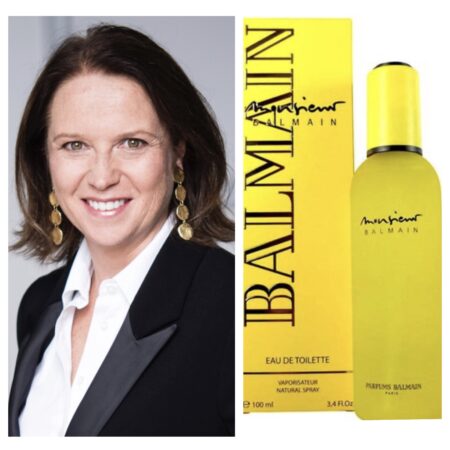
Vice President Perfumer and Director of the Givaudan Perfumery School via Givaudan and Fragrance Vault 1990 Monsieur Balmain
Madame Calice Becker was given the task of updating Monsieur Balmain in 1990 (she went on to rework Vent Vert in 1991) for a contemporary audience, at a time when restrictions were in place with regards to the utilization of oakmoss. I believe that her iteration, taken by itself, without comparisons – remains a lovely piece of work and a successful variation-on-a-theme of the original. In her version, oakmoss is forgone, and basil gives way to mint, rosemary, thyme, caraway and black pepper. Jasmine is supplanted by rose, lemongrass by bitter orange; the musk remains in situ, while clary sage and nutmeg enhance Mme. Becker’s overall herbalcy. A soupçon of amber gentles Monsieur Balmain’s astringency; vetiver and sandalwood contribute a fascinating sylvan/earthy/somewhat leathery effect. Taken on its own merits, this olfactory modernization is polished to a fine finish, bright, and well-balanced.
Monsieur Balmain by Calice Becker Notes (1990): mint, bergamot, lemon, bitter orange, rosemary, ginger, pepper, caraway, rose, nutmeg, thyme, musk, amber, clary sage, sandalwood, vetiver
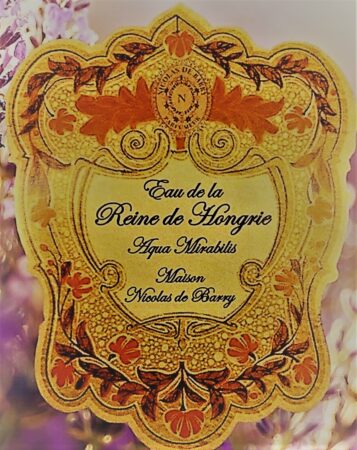
Maison Nicolas De Barry Historic Water of the Queen of Hungary free use
The pleasure of tracing aromatic antecedents and successors is multifold, enriching our understanding of the evolution of scent. What preceded Monsieur Balmain? We might venture as far back as the 14th century’s renowned Eau d’Hongrie, ostensibly created for Elizabeth of Hungary, aka Hungary Water. While it was a primarily herbal concoction in which rosemary, sage, thyme, lavender and jasmine often played their part, the famed perfumer to Marie Antoinette, Fargeon – recommended its soothing and restorative qualities to the Queen prior to the birth of her firstborn. A more recent offering is Paul Vacher’s 1953 Whip for Le Galion (an immense favorite among Meisters), which was delightfully reinterpreted by master perfumer Thomas Fontaine in 2014. Our beloved Dior Eau Sauvage (Edmond Roudnitska) followed Monsieur Balmain two years later; Yuri Gutsatz’s 1978 Verveine d’Été (Le Jardin Retrouvé) bears striking similarities as well; and Chris Maurice’s 2010 Xerjoff Casmorati Fiero resembles a more lasting, potent interpretation a full twenty years after Mme. Becker revamped the original Monsieur Balmain. So, to those who might eschew Monsieur Balmain as a dated fragrance, there is reason to believe that such delicious scents never seem to rust, bust, or lose their color – or appeal – and I don’t foresee that changing any time soon.
Perfumes from my personal collection; my nose is my own…
~ Ida Meister, Deputy and Natural Perfumery Editor
For further Balmain reviews, see Jolie Madame, Vent Vert, Miss Balmain, Élysées 64-83, Balmain de Balmain, Ivoire
Please read Michelyn’s Interview with Calice Becker
Editor’s Note: 1990 Monsieur Balmain is available at Fragrance Vault
Follow us in Instagram @cafleurebonofficial @idameister @calicebecker
This is our Privacy and Draw Rules Policy

